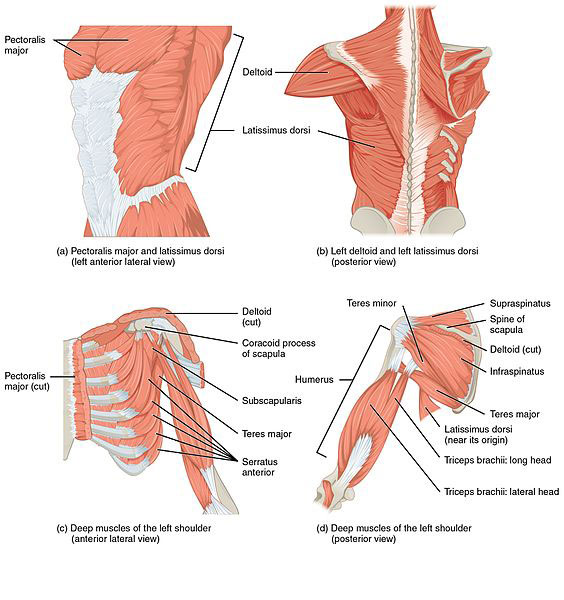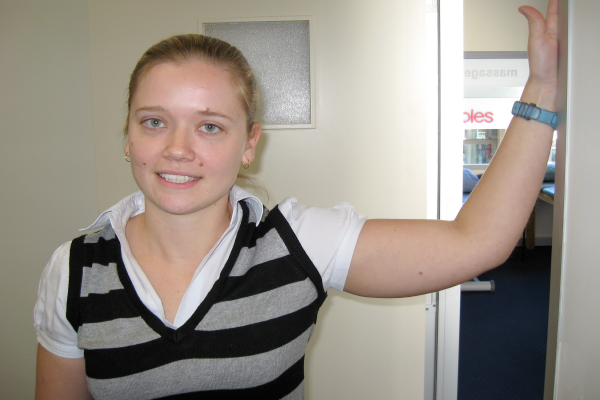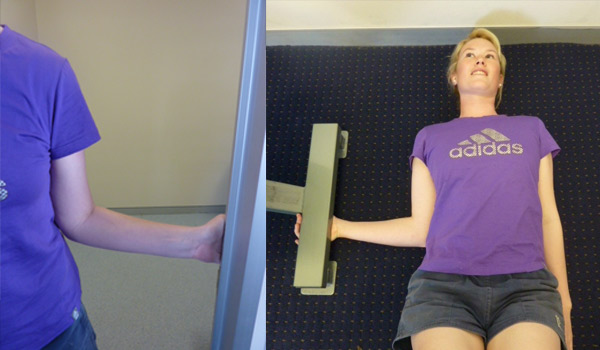The Top 3 Stretches to Help Treat and Prevent Swimmer’s Shoulder
Swimmer’s shoulder is a term that covers a broad range of injuries that occur in swimmers. You can injure various parts of your shoulder whilst swimming. It is important to know what structures are involved and why. There is a great balance between shoulder mobility and stability that occurs during sports that require overhead movements. A competitive swimmer can perform 4000 strokes for one shoulder in a single training session. This repetitive action can place great stress on the shoulder and result in injury.
Shoulder pain is the most common musculoskeletal complaint in swimming (up to 87% of swimmers in one particular study). We have also covered shoulder pain in a previous post How to fix shoulder pain – physio or surgery?. Swimmer’s shoulder can range from localised pain near the shoulder joint, to a radiating or shooting pain. The purpose of this post is to provide you with information about the biomechanics of swimming, the causes, diagnosis and treatment of swimmers shoulder, and the top 3 stretches most commonly utilised to help treat and prevent swimmers shoulder.
Shoulder Anatomy
The shoulder is a ball and socket joint, with a rim of cartilage (called the labrum) that goes around the socket to make the socket deeper and more stable. Surrounding the joint is your joint capsule with thicker parts of the capsule forming ligaments. A group of 4 muscles called the rotator cuff surrounds the joint and provides further stability and control to the movement of the humeral head. Further muscles attach on various sites on the humerus, scapula, clavicle, and rib cage to provide movement and support.


Swimming Mechanics
Swimming requires several different shoulder motions depending on the stroke. Most movements involve circular motions of the shoulder with varying degrees of internal and external rotation and scapular movements towards and away from the spine. Swimming is comprised of four different strokes including freestyle, butterfly, backstroke, and breastroke. Most strokes are divided into two primary phases referred to as the pull-through and recovery phases. The pull-through phase provides the propulsion and is further divided into different phases consisting of the hand entry, the catch, mid-pull, and finish or end pull-through. I will use slightly technical language to describe the movements of the shoulder. If you are not familiar with these terms please refer to the diagram.

Freestyle
Freestyle requires a combined motion of scapular retraction and elevation, with humeral abduction and external rotation during the recovery phase. During the pull-through phase, the scapula is protracted while the humerus is adducted, extended, and internally rotated. Stroke power is achieved through the shoulder adductors, extenders, and internal rotators with the serratus anterior and latissumus dorsi being the key propulsion muscles for swimmers.
Butterfly
Butterfly has a similar motion at the shoulder as freestyle, but the stresses are different because both arms are moved through the same motion simultaneously rather than alternating. For this reason, no trunk rotation occurs so the demand of the medial scapular stabilizers and retractors during recovery is greater with butterfly than freestyle. In addition, the humeral head moves into an impingement position of elevation, horizontal adduction, and internal rotation at hand entry.
Backstroke
Backstroke is opposite to the freestyle stroke with the shoulder in retraction, horizontal abduction, and external rotation at hand entry and the beginning of the pull-through phase. This position places increased stress on the front of the shoulder capsule. The arm position during the recovery phase is different than freestyle because the elbow is extended (rather than flexed).
Breaststroke
Breastroke technique is very different from the other strokes as the arms are moved simultaneously through a motion that starts in full flexion with internal rotation. However, the elbows remain flexed during the pull-through until the humerus is fully adducted and brought into horizontal adduction with forearms touching each other. Unlike the other strokes, the hands never move below the hips so the high stress on the rotator cuff that occurs during the other strokes does not occur during breaststroke.
What is Swimmer’s Shoulder
As we have learned the shoulder is a very mobile joint, and it needs to be well controlled by the muscles and ligaments that surround the joint. Over-training, fatigue, hypermobility, poor stroke technique, weakness, or tightness can lead to your muscles and ligaments being overworked. If this goes on, injuries such as rotator cuff impingement and tendonitis, rotator cuff tears, bursitis, ligament, or cartilage damage can occur. Swimmer’s shoulder is a broad term that encompasses all of these conditions that can occurs in swimmers. Therefore, a more accurate diagnosis is necessary to properly treat your shoulder injury.
Causes of Swimmer’s Shoulder
Swimmer’s shoulder usually presents as impingement involving the rotator cuff tendon, biceps tendon, or subacromial bursa (small fluid filled sac under the acromion). Primary impingement involves compression of these structures between the acromion (end of the scapula) and greater tuberosity (top of the humerus). The cause of primary impingement is usually a tight posterior capsule (back of the shoulder) or abnormal acromion shape. However, primary impingement syndrome is less common in competitive swimmers than secondary impingement.
The mechanism of secondary impingement occurs through a series of impairments. Shoulder range of motion in swimmers typically has excessive external rotation and limited internal rotation. This shift in movement towards increased external rotation is an adjustment to the demands on the shoulder joint. The acquired laxity permits excessive external rotation, but places greater demand on the rotator cuff.
Failure of the rotator cuff and the scapular stabilizers to maintain the correct position of the shoulder may lead to increased stress on the tendons or compression of the tendons at the top of the shoulder. This problem usually starts with muscle fatigue and tightness.
Symptoms that develop as a result of fatigue can also affect stroke mechanics. In swimmers with painful shoulders, the hand may enter further away from the midline with the elbow dropping closer to the surface of the water. This change is usually made to avoid an impingement position of full elevation with internal rotation and horizontal adduction.
Diagnosis of Swimmer’s Shoulder
Getting the correct diagnosis is very important in order to get the best treatment, and to get you back in the pool as fast as possible. Your physiotherapists will perform an assessment of your shoulder to determine what part of the shoulder is causing your pain. They will also examine what has caused your shoulder to become painful in the first place. In some cases imaging of the shoulder such as ultrasound or MRI may be helpful.
Treatment of Swimmer’s Shoulder
The first step in treating Swimmer’s shoulder is addressing any related impairments. Because the clinical presentation usually involves pain related to inflammation, initial treatments may use ice, anti-inflammatory drugs and a manual techniques, such as joint mobilizations, massage and stretches. Potential common impairments that need to addressing include postural dysfunctions, tight anterior chest muscles, stiffness of the thoracic spine. Also, the loss of joint mobility or excessive joint mobility, tight posterior capsule, and impaired strength and endurance of the rotator cuff need to be addressed.
Postural impairments are managed through joint /soft tissue mobilization, flexibility, and strengthening/stabilization exercises of the scapular retractors and postural neck muscles.
Scapular stability and proper movement is an essential element of shoulder rehabilitation and prevention. Scapular position directly affects humeral head position which can place increase stress on the rotator cuff muscles, potentially leading to injury.
Normally strengthening exercises for the rotator cuff are prescribed. Strengthening of the shoulder may start with isometric exercises (holding a position against resistance). Then can be progressed to dynamic strengthening of the rotator cuff and shoulder in different positions. Resistance can be applied with resistance bands, or with weights. These exercises can be advanced based on the range of motion and symptoms.
Altering the athletes training program is often necessary. Reducing your distance or training frequency is beneficial. Altering training patterns so that there is more variation in the swimming strokes may also be a good idea. This alteration will reduce the repetitive stress at the shoulder and allow the muscles to function differently. Avoiding the use of hand paddles will further reduce the stress on the shoulder. The use of fins to enhance the propulsion from the legs can also reduce such stress.
Top 3 Stretches to Help Treat Swimmers Shoulder
The most common problem areas or areas of tightness/stiffness that need correcting in swimmers shoulder injuries are the pectoral muscles, the posterior rotator cuff muscles and the thoracic spine. Our top 3 stretches will address these 3 areas. These may be helpful for you but please take note that these stretches are not for everyone, if you suffer from shoulder pain please see your physiotherapist first to accurately diagnose your injury before doing these stretches.
-
Pec Major Stretch – Stop Sign

Sit on the ground. Put your legs out to the side with your knees bent and the soles of your feet together. Keep your back straight put your elbows on your thighs or your knees and push towards the ground with your forearms.
-
Shoulder External Rotators / Lats Stretch

Against Door – Stand next to a door frame with your elbow by your side and bent out at 90°. Rotate your body forwards, keeping your elbow by your side until you feel a stretch in the front of your shoulder.Sustained on Floor – Lie on your back with your elbow by your side and bent out to 90°. Wedge your hand under a fixed item and keep your shoulder flat on the ground.
-
Thoracic Spine Mobility (with thoracic wedge or roller)

Lie on your back with your knees bent up and place the wedge under your thoracic spine and relax over the wedge. Place a towel over the wedge if it feels too uncomfortable. Beginner – arms crossed over chest. Advanced – arms behind head. Upper thoracic – lift your bottom in the air and push upwards through your legs to increase the force through the wedge. Mid-Lower thoracic – bottom down
Summary
Swimmer’s shoulder is a common injury for high level or dedicated recreational swimmers. The shoulder has great mobility compared to the other joints in the body, but such mobility sacrifices stability. Any impairment of movement or dysfunction of the shoulder may lead to injury. If you have shoulder pain from swimming you should have your shoulder assessed by a physiotherapist before trying any exercises. These 3 stretches are also particularly helpful in the prevention of shoulder injuries.
References
https://www.physiotherapy.asn.au/DocumentsFolder/CONFERENCE%202013/Sports%20-%20MelbourneAPA_2013_swimmershoulder_presentation%20-%20CraigB%20%5BCompatibility%20Mode%5D.pdf
https://www.ncbi.nlm.nih.gov/pmc/articles/PMC2953356/
http://emedicine.medscape.com/article/93213-overview#a7
https://www.shoulderdoc.co.uk/article/769
https://www.swimmingcoach.org/journal/manuscript-becker.pdf
Photo Attribution: By Australian Paralympic Committee, CC BY-SA 3.0, https://commons.wikimedia.org/w/index.php?curid=24354615

